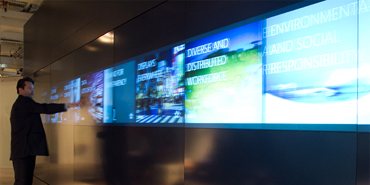Last month, Mashable had an interesting post on the future of digital displays that I found fascinating. Lauren Hockenson talked with experts about the rise of digital displays in airports, retail environment and our streets.
This is an area Microsoft is a big believer in – and we believe that in the near future, almost every surface in our lives could become not only digital but interactive. It’s something I’ve blogged about here several times and it seems as each week passes it, more progress is being made. In the last 2 weeks, I’ve seen more projects and products that will be a big part of this trend:
- Perceptive Pixel – at Microsoft’s Worldwide Partner Conference (WPC) we announced the acquisition of Jeff Han’s company, sometimes referred at as PPI. They manufacture up to 82” touch screens that have to been seen (and touched) to be believed. The resolution is incredible and they can be used with touch (fingers) or styli. It makes for a breakthrough in conference collaboration experiences – a wall sized display that can be used at distance or right up close. That latter part is what makes this very different from many others displays I have seen and makes for an amazing immersive experience.
- Windows 8 PCs – seeing Windows 8 on the 82” PPI display was impressive – especially using the Metro style interface for apps like weather and news. However, another thing I saw at WPC was the amount of new PCs that will be touch screen devices. An Acer ultrabook in particular caught my eye, as did the much talked about Lenovo Yoga PC. We’re all used to touching smartphones of course but almost every other screen we interact with (apart from TV’s) are touch screens – the ATM machine, the gas station screen, the airport check in kiosk etc. Watching the Windows 8 PCs demo made me realize that the next generation will grow up simply expecting and display to be interactive.
- Kinect “touchscreens” – when I visited the Kinect Accelerator a few months ago, the first project that really stopped me in my tracks was from Ubi-Interactive. They were kind enough to join me on stage at WPC to demo their technology that literally does turn any surface in to an interactive digital display. In fact, with their technology a user doesn’t even need to touch the surface – they can do that, but they can also gesture near the surface and their interactions can be captured. Ubi utilizes Kinect to track a user in 3D space and interpret gesture or taps in to click on a PC screen. You basically become the mouse and with a Kinect and projector combo, the Ubi technology can work on almost any surface. After reading the Mashable post, I can see many uses for their technology in airports and retail.
- Windows Embedded – Lauren’s post mentions large format displays in places such as Times Square. It turns out many of those displays are powered by our Windows Embedded technology. In fact Windows Embedded is in more places than you may expect (including the aforementioned ATM’s and gas pumps). This short video gives an insight in to how much we have going on with Windows Embedded – a sometimes overlooked but fascinating part of our Windows family.
I long for the flexible display tech mentioned in the Mashable post but that’s just one part of this journey we’re on where every surface is interactive. It’s set to be an exciting few years in this field, where I think the real trick will be employing all of this technology in a non-intrusive, helpful manner. More on that later this week – I’ll close by sharing the Office Vision video from late last year which shows the breath of our vision for displays.




